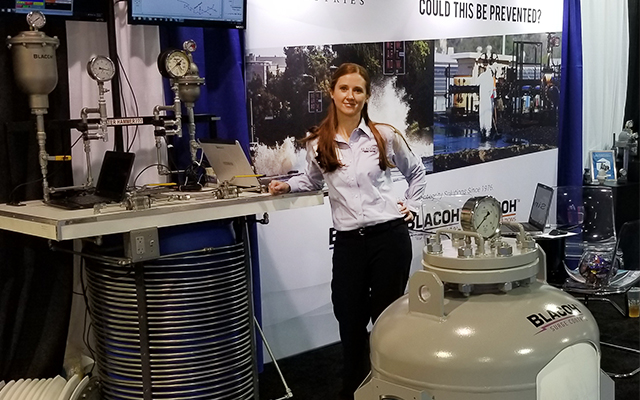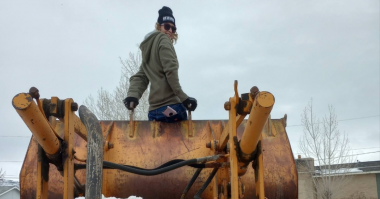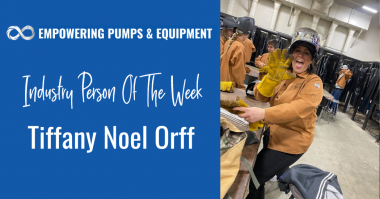When Empowering Pumps and Equipment was at the Texas Water Conference in April, we had the great fortune of meeting Amy Marroquin, Project Manager with Blacoh Surge Control. We invited her to be a Pump Person of the Week and this is what she had to share!
Q. What inspired you to become an engineer? How did you get started working in the pump industry?
Amy: My dad is ‘all things technical’ and probably the leading source of encouragement for me to become an engineer. He is a man of all trades and was absolutely driven to see that my brother and I complete college. In college, I was introduced to the pump industry where I had the opportunity to assist a professor with research on labyrinth seals at Texas A&M’s Turbomachinery Lab. Fast forward about 15years (yikes!) and I can look back to a whirlwind of rotating equipment and fluid analyses.
 Join our LinkedIn Group:
Join our LinkedIn Group:
Empowering Women in Industry!
Q. What is your favorite part of your job? What are you most proud of? What do you love about working in the pump industry?
Amy: I take pride in good work – which for me ranges from changing diapers to computer modeling, but this pride also includes emphasizing the good work of others. Any job and passion can be compromised if you’re not working with a killer team. When I was approached to become a part of the Blacoh team, I did my research and was taken back by just how awesome this team is. My family actually had some concerns the whole opportunity was a hoax because of how well of a fit it was for me. If you’re curious to know more, look us up on social media, Blacoh University, or even better – watch one of our “Be Entertained” videos on You Tube. You will quickly see our core values, Team-Driven, Diligent, Authentic, Curious, Customer-Focused, Humble, Fun-Loving and Happy.
Q. What advice would you give to someone new to the industry?
Amy: Without a doubt, I would encourage everyone to understand water hammer. Water hammer has been historically tagged as a “phenomenon” and not something routinely considered in the design phases of the millions of pipelines in America. No matter the fluid, when the velocity of the fluid changes, a sound wave is formed. This sound wave can all too often contain enough energy to pack a pretty hefty punch. What is sometimes hard to picture is that the sound wave is traveling through the system at the speed of sound, which in a typical steel pipeline could easily exceed 4,000 ft./sec. Imagine closing a valve or losing power to a pump, then hearing of a break a mile down the pipeline. Is this a coincidence? No, that pressure wave attacked the weakest (perhaps most corroded) component of the pipeline.
Blacoh has created a simple demonstration unit that showcases this reality from two different sources. The unit consists of a drum with about 200 ft. of stainless steel tubing wrapped around it. Water flows through the tubing via a submersible pump in the drum. The steady state pressure is about 50 psig at the outlet of the pump and 0 psig at the discharge as the drum is open to atmosphere. Here’s the cool part! If I close the valve at the outlet of the pump (simulating a loss of power to the pump), I can watch the pressure dive into a vacuum state. If I close a valve at the end of the system, the pressure spikes from 0 psig to almost 400 psig!! How do I see this? Well, the standard pressure dial gauges give me some indicator of a problem, but because they cannot react at the speed of sound, it’s Blacoh’s SurgeWave™ Transient Monitoring System that really provides the data. This device is detecting pressures at 500 times per second! Sounds extreme but considering the wave speed, transient monitoring becomes necessary.
Beyond diagnosing the problem, however, is designing a solution and proving it. It’s a rewarding day when we commission a solution that was modeled and physically proven in the field with transient monitoring. Solutions vary with each system, but we commonly see surge vessels as the most effective way of mitigating surge pressures. Without breaking containment, surge vessels can give energy to the system when vacuum pressures are plausible, and they can receive energy from the induced high pressure shock waves. In fact, surge vessels can greatly reduce the amount of fatigue a pipe can experience as the pressure wave travels back and forth. Without such a solution, the pipe will see extreme ranges in pressure from negative pressures to high positive pressures in a matter of just a few seconds. Breaks in this case are inevitable.
Q. What are the top 5 questions you get asked by your customers? How do you answer them?
Can you help!? I have worked with countless teams outside of Blacoh that are, to put it bluntly, fed up. So much time, energy, cost and sometimes even blame goes into improving any piping system. It’s very refreshing when Blacoh models a system during the design phase, but more often it seems we are looking at existing systems. The answer is yes, we can help! Our days, my days, are spent reviewing systems and working together to determine real solutions.
How can you help? It all starts with a computer model. We are fortunate in this day to have sophisticated software that can relieve us from the computational burden of properly analyzing a system. Whether it is a Method of Characteristics or Wave Characteristic based analysis, our resources for hydraulic modeling are vastly more efficient than those available 30-40 years ago. Not to mention, they are just plain cool.
What information do you need? A hydraulic model starts with a good description of the system. Understanding the fluid properties, steady state pressures and flows is key. Next is mapping out the system via P&IDs, Isometrics, pictures, sometimes even a sketch. Following this is modeling what operating scenarios can and likely will happen. Such scenarios might include a loss of power to a pump station, a quick closing valve, a break in a pipe, even pump startups. Last comes modeling effective solutions.
How much does it cost? The question that makes everyone cringe. There is especially a lot of cringing when considering a purchase of a vessel versus a relief valve. This, of course, is not a platform to list out actual pricing but what I can say is all customers are faced with determining the true cost of a failure. Many customers unfortunately do not have real data to use. Think about just one fluid in particular, water. Recently, Utah University completed a 12-month study of the number of water main breaks in the US and Canada. From their study they have computed the overall break rate for 2018 to be 14 breaks for every 100 miles of pipeline, per year1. The cost and health risks associated with each break quickly surpasses the cost of a proper protective solution. Now jump over to systems with other fluids – oil, frac water, complex chemicals. Lots and lots of cringing.
How will I see results? It all looks good on paper right? With transient monitoring, it’s possible to not only diagnose a problem, but also prove a solution. During startup and commissioning, Blacoh’s transient monitoring equipment is used to compare live data to that of the computer model. It’s great that these align; a proof of good work!
Q. Can you tell us about any projects you are working on?
Amy: The many different applications keep things interesting. This year I have modeled a 24” potable water system spanning 2-1/2 miles with a flowrate of 3,500 gpm. In this system we sized a 2,000-gallon surge vessel to give energy in the event of a power loss, mitigating the risk of cavitation. Another potable water project included modeling the water system of a high rise building, where a 150-gallon vessel did the trick.
Yet another active project consists of a diesel fuel barge dock where quick closing valves are causing pressure spikes more than 7 times normal operating pressure. I’ve seen numerous applications just this year ranging from water, waste, various food industry fluids, crude oil, frac water – you name it.
On behalf of the entire team at Empowering Pumps & Equipment, Thank you for being our Pump Person of the Week! We look forward to keeping up with you as you continue advancing in your career in the Pump Industry! We know you will do great things!!
 Know an Amazing Person who is making valuable contributions within the Pump Industry? Nominate them to be “Pump Person of the Week”!
Know an Amazing Person who is making valuable contributions within the Pump Industry? Nominate them to be “Pump Person of the Week”!
MEET OUR OTHER INDUSTRY PROS!
References
- Folkman, Steven. “Water Main Break Rates In the USA and Canada: A Comprehensive Study” Utah State University Mechanical and Aerospace Engineering Faculty Publications, March 1, 2018.





Comments